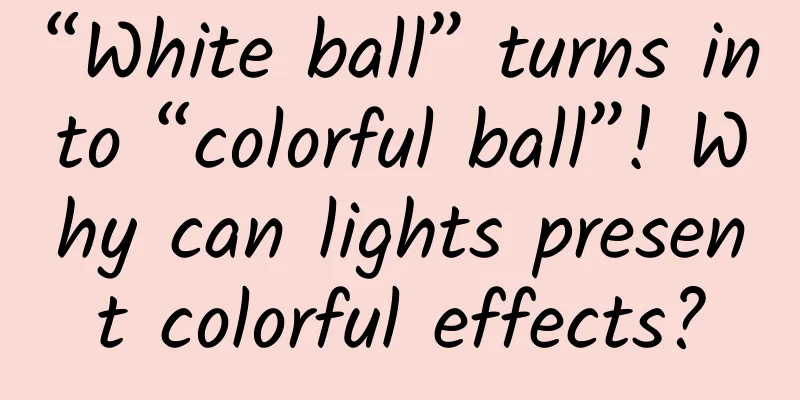“White ball” turns into “colorful ball”! Why can lights present colorful effects?

|
Review expert: Zhou Hongzhi, senior laboratory technician, master's supervisor, School of Physics and Optoelectronic Engineering, Beijing University of Technology With the arrival of winter, the Beijing Science Center Special Effects Theater has been renovated. As a landmark building on the Third Ring Road of Beijing, the white "sphere" of the Beijing Science Center has been renovated to create a lighting atmosphere, making it more dazzling at night. The colorful lights illuminate the landmark and also awaken the city's memory. Looking up at the constantly changing "sphere" lights, have you ever wondered: Why can neon lights show colorful lights? Why can some lights flash colorful colors by themselves? 01Are neon lights made of gas? Neon lights are derived from the English word “neon light”, and the word “neon” is actually the transliteration of “neon”. The protagonist of neon lights is a series of inert gases represented by neon gas. Neon is an inert gas element, which is ranked 10th in the periodic table, in the second row of the last column. All inert gas elements are in the last column, and the "helium, neon, argon, krypton, xenon, and radon" we learned in textbooks refer to them. Inert gases meet at least two characteristics: first, because their electronic structure is very complete, their chemical properties are very "lazy", and it is very difficult for them to react and transform into other substances; second, they are gaseous at normal temperature. 02How do noble gases emit light? Under the excitation of electromagnetic waves, noble gases will be ionized and in an excited state. However, due to their inertness, they will not undergo chemical reactions at this time. The excited inert gases are not stable and will return to their original ground state. In this process, they will inevitably release the received excitation energy at their inherent resonant frequency, and the release is still in the form of electromagnetic waves. If the frequency of this electromagnetic wave happens to be within the wavelength range of visible light, the human eye can see the light they emit. The special thing about neon lamps is that their spectrum is not only in the visible light range, but also very bright red. So soon after it was discovered, it was used as a filling gas in neon tubes. Nowadays we call all lights that use this type of light-emitting principle neon lights, but other colored lights are filled with other elements, such as helium that emits orange-red light, and argon that emits blue-violet light. 03New generation of lighting tools LED LED is the abbreviation of light emitting diode, which is a lighting lamp made of high-brightness light-emitting diodes. Its core part is a chip composed of p-type semiconductors and n-type semiconductors. The characteristic of the PN junction of the LED is the presence of a resonant cavity. When the excitation current arrives, the carriers will produce multiple reflections between this junction. When the designed frequency is reached, the energy will be radiated at a fixed frequency to form the light we see. 04Generation of Color Light Source To understand the principle of colorful LED light emission, first let's get to know the three primary colors of red (R), green (G), and blue (B). Different colors can be obtained by combining these three colors. For example, when red and green lights are on at the same time, the two lights mix to form yellow. The color-changing principle of the color-changing lamp is that when two LEDs of the three primary colors are lit separately, it can emit yellow, purple, and cyan (such as purple light when the red and blue LEDs are lit), and if the red, green, and blue LEDs are lit at the same time, it will produce white light. If there is a circuit that can light up the red, green, and blue LEDs in pairs, individually, or at the same time, and when the light intensity of each changes, it can emit seven or more different colors of light, thus creating the phenomenon of colored LED lights. Different colors are produced as the proportions of their superposition change. Relying on the brand-new lighting landscape, Beijing Science Center sincerely invites everyone, young and old, to witness the power of reshaping and renewal! We warmly welcome every visitor to come to the scene, capture the wonderful moments with your eyes and cameras, participate in lighting up the landmark, and leave a new and brilliant memory of the "sphere" and "Beijing Science Center"! |
>>: 37 years later, killer whales are using dead salmon as hats again | Nature Trumpet
Recommend
Learn design patterns for fun, say goodbye to bad code, and become a programming "artist"
Learn design patterns for fun, say goodbye to bad...
Could climate change thousands of years ago have changed the direction of the ancient Silk Road?
Professor Chen Jianhui's team at Lanzhou Univ...
A complete event operation and promotion!
All operating systems and organizations are only ...
Introduction to iQIYI’s effective promotion products
There is no doubt that iQiyi has taken the top sp...
The "magic weapon" for weight loss, the sweat-inducing suit, will make you pay the "IQ tax"?
As the temperature gradually rises, many beauty l...
Do you have any of these bad cooking habits?
Compared to eating out, do you think cooking at h...
The colorful black, the ever-changing white, the brilliant green... have been passed down for 100,000,000 years?
Audit expert: Luo Huiqian Associate Researcher, I...
Xue Li's "Elementary English Grammar"
: : : : : : : : : : : : : : :...
Why are there so many taboos about persimmons?
Every year when eating persimmons, there are alwa...
Introduction to iQIYI’s effective promotion products
There is no doubt that iQiyi has taken the top sp...
Chukong Technology officially releases "One-stop solution for game development"
On February 2, 2015, Chukong Technology officiall...
Do you need to change your toothbrush after having an orgasm?
As more and more people are infected with the new...
Instead of gushing out lava, they spit out mud. How much do you know about Xinjiang's mud volcanoes?
Your browser does not support the video tag The l...
iOS 18 is about to be released, get to know the new features first
The May Day holiday is approaching, which means i...
When will the willow catkins begin and end in 2022? Are the catkins floating in the air in spring willows or poplars?
Every April, various willow and poplar catkins wil...









